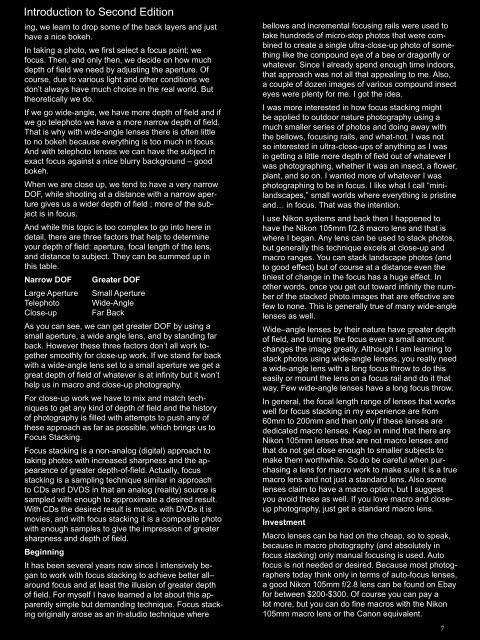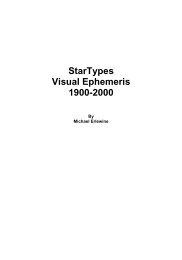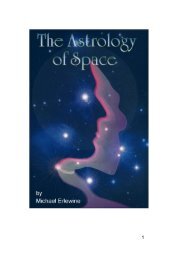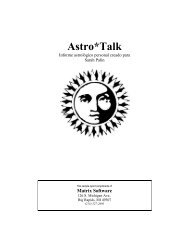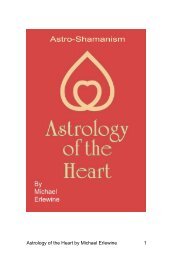The Art of Focus Stacking - Matrix Software
The Art of Focus Stacking - Matrix Software
The Art of Focus Stacking - Matrix Software
You also want an ePaper? Increase the reach of your titles
YUMPU automatically turns print PDFs into web optimized ePapers that Google loves.
Introduction to Second Edition<br />
ing, we learn to drop some <strong>of</strong> the back layers and just<br />
have a nice bokeh.<br />
In taking a photo, we first select a focus point; we<br />
focus. <strong>The</strong>n, and only then, we decide on how much<br />
depth <strong>of</strong> field we need by adjusting the aperture. Of<br />
course, due to various light and other conditions we<br />
don’t always have much choice in the real world. But<br />
theoretically we do.<br />
If we go wide-angle, we have more depth <strong>of</strong> field and if<br />
we go telephoto we have a more narrow depth <strong>of</strong> field.<br />
That is why with wide-angle lenses there is <strong>of</strong>ten little<br />
to no bokeh because everything is too much in focus.<br />
And with telephoto lenses we can have the subject in<br />
exact focus against a nice blurry background – good<br />
bokeh.<br />
When we are close up, we tend to have a very narrow<br />
DOF, while shooting at a distance with a narrow aperture<br />
gives us a wider depth <strong>of</strong> field ; more <strong>of</strong> the subject<br />
is in focus.<br />
And while this topic is too complex to go into here in<br />
detail, there are three factors that help to determine<br />
your depth <strong>of</strong> field: aperture, focal length <strong>of</strong> the lens,<br />
and distance to subject. <strong>The</strong>y can be summed up in<br />
this table.<br />
Narrow DOF Greater DOF<br />
Large Aperture Small Aperture<br />
Telephoto Wide-Angle<br />
Close-up Far Back<br />
As you can see, we can get greater DOF by using a<br />
small aperture, a wide angle lens, and by standing far<br />
back. However these three factors don’t all work together<br />
smoothly for close-up work. If we stand far back<br />
with a wide-angle lens set to a small aperture we get a<br />
great depth <strong>of</strong> field <strong>of</strong> whatever is at infinity but it won’t<br />
help us in macro and close-up photography.<br />
For close-up work we have to mix and match techniques<br />
to get any kind <strong>of</strong> depth <strong>of</strong> field and the history<br />
<strong>of</strong> photography is filled with attempts to push any <strong>of</strong><br />
these approach as far as possible, which brings us to<br />
<strong>Focus</strong> <strong>Stacking</strong>.<br />
<strong>Focus</strong> stacking is a non-analog (digital) approach to<br />
taking photos with increased sharpness and the appearance<br />
<strong>of</strong> greater depth-<strong>of</strong>-field. Actually, focus<br />
stacking is a sampling technique similar in approach<br />
to CDs and DVDS in that an analog (reality) source is<br />
sampled with enough to approximate a desired result.<br />
With CDs the desired result is music, with DVDs it is<br />
movies, and with focus stacking it is a composite photo<br />
with enough samples to give the impression <strong>of</strong> greater<br />
sharpness and depth <strong>of</strong> field.<br />
Beginning<br />
It has been several years now since I intensively began<br />
to work with focus stacking to achieve better all–<br />
around focus and at least the illusion <strong>of</strong> greater depth<br />
<strong>of</strong> field. For myself I have learned a lot about this apparently<br />
simple but demanding technique. <strong>Focus</strong> stacking<br />
originally arose as an in-studio technique where<br />
bellows and incremental focusing rails were used to<br />
take hundreds <strong>of</strong> micro-stop photos that were combined<br />
to create a single ultra-close-up photo <strong>of</strong> something<br />
like the compound eye <strong>of</strong> a bee or dragonfly or<br />
whatever. Since I already spend enough time indoors,<br />
that approach was not all that appealing to me. Also,<br />
a couple <strong>of</strong> dozen images <strong>of</strong> various compound insect<br />
eyes were plenty for me. I got the idea.<br />
I was more interested in how focus stacking might<br />
be applied to outdoor nature photography using a<br />
much smaller series <strong>of</strong> photos and doing away with<br />
the bellows, focusing rails, and what-not. I was not<br />
so interested in ultra-close-ups <strong>of</strong> anything as I was<br />
in getting a little more depth <strong>of</strong> field out <strong>of</strong> whatever I<br />
was photographing, whether it was an insect, a flower,<br />
plant, and so on. I wanted more <strong>of</strong> whatever I was<br />
photographing to be in focus. I like what I call “minilandscapes,”<br />
small worlds where everything is pristine<br />
and… in focus. That was the intention.<br />
I use Nikon systems and back then I happened to<br />
have the Nikon 105mm f/2.8 macro lens and that is<br />
where I began. Any lens can be used to stack photos,<br />
but generally this technique excels at close-up and<br />
macro ranges. You can stack landscape photos (and<br />
to good effect) but <strong>of</strong> course at a distance even the<br />
tiniest <strong>of</strong> change in the focus has a huge effect. In<br />
other words, once you get out toward infinity the number<br />
<strong>of</strong> the stacked photo images that are effective are<br />
few to none. This is generally true <strong>of</strong> many wide-angle<br />
lenses as well.<br />
Wide–angle lenses by their nature have greater depth<br />
<strong>of</strong> field, and turning the focus even a small amount<br />
changes the image greatly. Although I am learning to<br />
stack photos using wide-angle lenses, you really need<br />
a wide-angle lens with a long focus throw to do this<br />
easily or mount the lens on a focus rail and do it that<br />
way. Few wide-angle lenses have a long focus throw.<br />
In general, the focal length range <strong>of</strong> lenses that works<br />
well for focus stacking in my experience are from<br />
60mm to 200mm and then only if these lenses are<br />
dedicated macro lenses. Keep in mind that there are<br />
Nikon 105mm lenses that are not macro lenses and<br />
that do not get close enough to smaller subjects to<br />
make them worthwhile. So do be careful when purchasing<br />
a lens for macro work to make sure it is a true<br />
macro lens and not just a standard lens. Also some<br />
lenses claim to have a macro option, but I suggest<br />
you avoid these as well. If you love macro and closeup<br />
photography, just get a standard macro lens.<br />
Investment<br />
Macro lenses can be had on the cheap, so to speak,<br />
because in macro photography (and absolutely in<br />
focus stacking) only manual focusing is used. Auto<br />
focus is not needed or desired. Because most photographers<br />
today think only in terms <strong>of</strong> auto-focus lenses,<br />
a good Nikon 105mm f/2.8 lens can be found on Ebay<br />
for between $200-$300. Of course you can pay a<br />
lot more, but you can do fine macros with the Nikon<br />
105mm macro lens or the Canon equivalent.<br />
7


